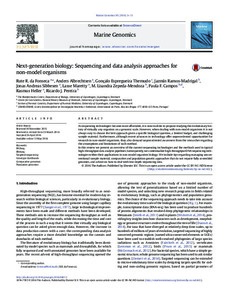| dc.contributor.author | da Fonseca, Rute R. | |
| dc.contributor.author | Albrechtsen, Anders | |
| dc.contributor.author | Espregueira Themudo, Gonçalo | |
| dc.contributor.author | Ramos-Madrigal, Jazmín | |
| dc.contributor.author | Sibbesen, Jonas Andreas | |
| dc.contributor.author | Maretty, Lasse | |
| dc.contributor.author | Zepeda-Mendoza, M. Lisandra | |
| dc.contributor.author | Campos, Paula F. | |
| dc.contributor.author | Heller, Rasmus | |
| dc.contributor.author | Pereira, Ricardo J. | |
| dc.date.accessioned | 2019-08-09T21:45:42Z | |
| dc.date.available | 2019-08-09T21:45:42Z | |
| dc.date.issued | 2016 | |
| dc.identifier.citation | da Fonseca, R.R.; Albrechtsen, A.; Espregueira Themudo, J.G.; Ramos-Madrigal, J.; Sibbesen, J.A.; Maretty, L.; Zepeda-Mendoza, M.L.; Campos, P.F.; Heller, R. and Pereira, R.J. (2016) Next-generation biology: Sequencing and data analysis approaches for non-model organisms. Marine Genomics, 6, pp.3-13. DOI: https://doi.org/10.1016/j.margen.2016.04.012. | en_US |
| dc.identifier.uri | http://hdl.handle.net/11329/1012 | |
| dc.identifier.uri | http://dx.doi.org/10.25607/OBP-544 | |
| dc.description.abstract | As sequencing technologies become more affordable, it is now realistic to propose studying the evolutionary history of virtually any organism on a genomic scale. However, when dealing with non-model organisms it is not always easy to choose the best approach given a specific biological question, a limited budget, and challenging sample material. Furthermore, although recent advances in technology offer unprecedented opportunities for research in non-model organisms, they also demand unprecedented awareness from the researcher regarding the assumptions and limitations of each method.In this review we present an overview of the current sequencing technologies and the methods used in typical high-throughput data analysis pipelines. Subsequently,we contextualize high-throughput DNA sequencing technologies within their applications in non-model organism biology. We include tips regarding managing unconventional sample material, comparative and population genetic approaches that do not require fully assembled genomes, and advice on how to deal with low depth sequencing data. | en_US |
| dc.language.iso | en | en_US |
| dc.rights | Attribution-NonCommercial-NoDerivatives 4.0 International | * |
| dc.rights.uri | http://creativecommons.org/licenses/by-nc-nd/4.0/ | * |
| dc.subject.other | RADseq | en_US |
| dc.subject.other | RNAseq | en_US |
| dc.subject.other | Targeted sequencing | en_US |
| dc.subject.other | Genotype likelihoods | en_US |
| dc.subject.other | Comparative genomics | en_US |
| dc.subject.other | Population genomic | en_US |
| dc.title | Next-generation biology: Sequencing and data analysis approaches fornon-model organisms. | en_US |
| dc.type | Journal Contribution | en_US |
| dc.description.refereed | Refereed | en_US |
| dc.format.pagerange | pp.3-13 | en_US |
| dc.identifier.doi | https://doi.org/10.1016/j.margen.2016.04.012 | |
| dc.subject.parameterDiscipline | Parameter Discipline::Biological oceanography::Other biological measurements | en_US |
| dc.subject.dmProcesses | Data Management Practices::Data analysis | en_US |
| dc.bibliographicCitation.title | Marine Genomics | en_US |
| dc.bibliographicCitation.volume | 6 | en_US |
| dc.description.sdg | 14 | en_US |
| dc.description.bptype | Best Practice | en_US |
| dc.description.bptype | Guide | en_US |
| obps.contact.contactname | R.R. da Fonseca | |
| obps.contact.contactemail | fonseca@binf.ku.dk | |
| obps.resourceurl.publisher | https://www.sciencedirect.com/science/article/pii/S1874778716300368 | en_US |
 Repository of community practices in Ocean Research, Applications and Data/Information Management
Repository of community practices in Ocean Research, Applications and Data/Information Management

